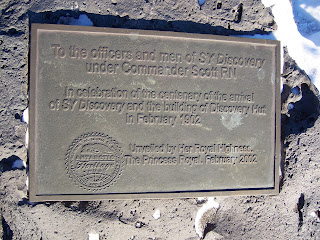- Severe Weather Condition 1
Issued when at least one of the following conditions is occurring or imminent:
Sustained wind speed greater than 55 knots
Wind chill temperature colder than -100°F (-73°C)
Visibility less than 100 feet - Severe Weather Condition 2
Issued when at least one of the following conditions is occurring or imminent:
Sustained wind speed 48 knots to 55 knots
Wind chill temperature -75°F (-60°C) to -100°F (-73°C)
Visibility 1/4 mile to 100 feet - Severe Weather Condition 3
Issued when all conditions exceed criteria for Condition 2. This is the normal condition.
If you are unfamiliar with knots as a speed indicator, I found out that a knot is equal to 1.15 miles per hour.
This YouTube video shows a Condition One here at McMurdo. It is was not made yesterday, but it is quite an accurate portrayal of the event.
When there is Condition One, everyone is required to remain indoors and not to go outside. I was, fortunately, in the hospital where we have the comforts of home: kitchenette, snacks, restroom, beds, computers, and TV. The Condition One lasted from about 7 am to noon and was more impressive than the hurricane I experienced in Houston back in the early 1980's. The snow here is as fine as baby powder, but when it hits you it feels like needles. Larger pieces of snow can feel like bullets. The wind will knock you over. I saw a recycling bin, a huge wooden box, blown down the street. A large piece of plywood took flight. Snow was blowing into the hospital's break room through a tiny crack above a window. Some buildings suffered minor damage or had windows blow out.
Last night the Carpenter's Shop, known locally as the "carp shop", hosted CarpStock - a party featuring about 4 or 5 rock bands, grilled hot dogs and hamburgers, lots of other munchies, and a variety of beverages. Everyone seemed to have a great time enjoying the music, dancing and letting out the stress of a busy week and lousy weather.
Tonight, at 8 pm, we will be treated to another Science Lecture. Tonight's subject will be on a variety of weather topics, such as Fata Morgana (Wikipedia Link) and other oddities. These are always interesting and topical presentations by leaders in their field.
Earlier today there was a craft fair. Local artisans showed a variety of amazing talents in photography, jewelry, knitting, and ceramics. I am continually impressed by the talent we have on station.
As some may know, I am Jewish. Jews celebrate Rosh Hashanah and Yom Kippur, our High Holy Days (HHDs), in the coming weeks. Celebrating them here, at McMurdo, is a bit of a challenge.
 We have a non-denominational Christian chapel (Chapel of the Snows) and arriving soon will be a military chaplain and a Catholic priest. However, there is no facility, liturgy, or accomodation for Jews to observe these holidays. My request to be permitted to view streaming audio or video of services from a (technologically progressive) Synagogue in the U.S. was denied. There is a strict policy against permitting streaming audio/video due to bandwidth limitations and it is the opinion of station management that any variance from this policy, regardless of how worthy, would lead to other worthy requests. The concern, as explained to me, is that to make an exception for one would require an exception to all, and there is no desire to have that happen. So, for me, observing the HHDs will require finding printed resources online and trying to conduct self-guided worship. This should be an interesting experience. I'll let you know how it goes.
We have a non-denominational Christian chapel (Chapel of the Snows) and arriving soon will be a military chaplain and a Catholic priest. However, there is no facility, liturgy, or accomodation for Jews to observe these holidays. My request to be permitted to view streaming audio or video of services from a (technologically progressive) Synagogue in the U.S. was denied. There is a strict policy against permitting streaming audio/video due to bandwidth limitations and it is the opinion of station management that any variance from this policy, regardless of how worthy, would lead to other worthy requests. The concern, as explained to me, is that to make an exception for one would require an exception to all, and there is no desire to have that happen. So, for me, observing the HHDs will require finding printed resources online and trying to conduct self-guided worship. This should be an interesting experience. I'll let you know how it goes.
























